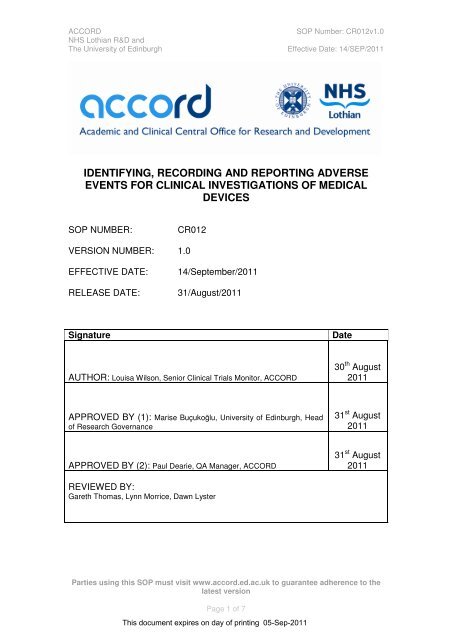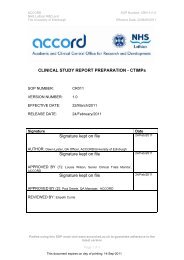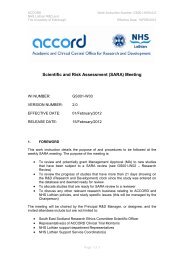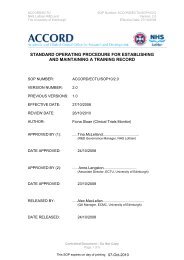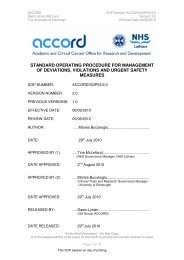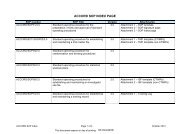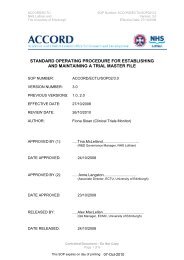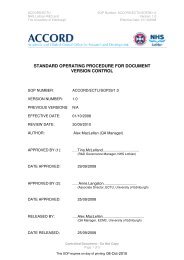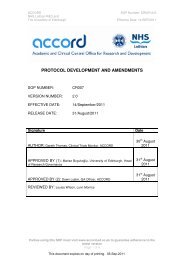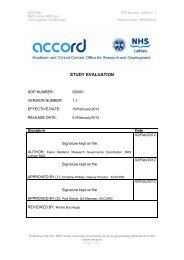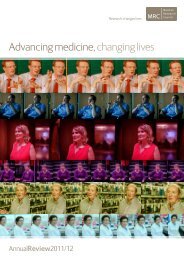Identifying, recording and reporting AEs for clinical ... - Accord
Identifying, recording and reporting AEs for clinical ... - Accord
Identifying, recording and reporting AEs for clinical ... - Accord
You also want an ePaper? Increase the reach of your titles
YUMPU automatically turns print PDFs into web optimized ePapers that Google loves.
ACCORD<br />
NHS Lothian R&D <strong>and</strong><br />
The University of Edinburgh<br />
SOP Number: CR012v1.0<br />
Effective Date: 14/SEP/2011<br />
IDENTIFYING, RECORDING AND REPORTING ADVERSE<br />
EVENTS FOR CLINICAL INVESTIGATIONS OF MEDICAL<br />
DEVICES<br />
SOP NUMBER:<br />
CR012<br />
VERSION NUMBER: 1.0<br />
EFFECTIVE DATE:<br />
RELEASE DATE:<br />
14/September/2011<br />
31/August/2011<br />
Signature<br />
Date<br />
AUTHOR: Louisa Wilson, Senior Clinical Trials Monitor, ACCORD<br />
30 th August<br />
2011<br />
APPROVED BY (1): Marise Buçukolu, University of Edinburgh, Head<br />
of Research Governance<br />
31 st August<br />
2011<br />
APPROVED BY (2): Paul Dearie, QA Manager, ACCORD<br />
31 st August<br />
2011<br />
REVIEWED BY:<br />
Gareth Thomas, Lynn Morrice, Dawn Lyster<br />
Parties using this SOP must visit www.accord.ed.ac.uk to guarantee adherence to the<br />
latest version<br />
Page 1 of 7
ACCORD<br />
NHS Lothian R&D <strong>and</strong><br />
The University of Edinburgh<br />
SOP Number: CR012v1.0<br />
Effective Date: 14/SEP/2011<br />
1. INTRODUCTION<br />
Adverse Device Effects (ADEs) <strong>and</strong> other safety event identification, <strong>recording</strong> <strong>and</strong><br />
<strong>reporting</strong> procedures will comply with the requirements of the Medical Device<br />
Regulations 2002/618 <strong>and</strong> Good Clinical Practice (GCP).<br />
The Investigator will be responsible <strong>for</strong> identifying <strong>and</strong> <strong>reporting</strong> ADEs <strong>and</strong> other<br />
safety events as detailed in this procedure.<br />
ACCORD will be responsible <strong>for</strong> medical device vigilance <strong>for</strong> Clinical Investigations of<br />
Medical Devices (CIMDs) that are sponsored by NHS Lothian <strong>and</strong>/or the University of<br />
Edinburgh (UoE). This responsibility may not be delegated to the Investigator.<br />
Where NHS Lothian <strong>and</strong>/or UoE agrees to co-sponsor a CIMD with another<br />
organisation the responsibility <strong>for</strong> medical device vigilance must be agreed between<br />
both organisations be<strong>for</strong>e the trial commences <strong>and</strong> should be clearly documented in<br />
a <strong>clinical</strong> trial agreement or equivalent.<br />
2. PURPOSE<br />
To describe the procedure <strong>for</strong> identifying, <strong>recording</strong> <strong>and</strong> <strong>reporting</strong> <strong>AEs</strong> <strong>and</strong> other<br />
safety events occurring in CIMDs that are sponsored by NHS Lothian <strong>and</strong>/or the<br />
UoE.<br />
3. SCOPE<br />
This SOP applies to <strong>clinical</strong> researchers participating in CIMDs sponsored by NHS<br />
Lothian <strong>and</strong>/or the University of Edinburgh (UoE). This SOP is also applicable to<br />
ACCORD members of staff responsible <strong>for</strong> medical device vigilance.<br />
4. REFERENCES<br />
The Medical Device Regulations (SI: 2002/618) as amended<br />
5. PROCEDURE<br />
5.1 Definitions<br />
Adverse Device Effect (ADE)<br />
Adverse event related to the use of an investigational medical device.<br />
NOTE 1- This includes any adverse event resulting from insufficiencies or<br />
inadequacies in the instructions <strong>for</strong> use, the deployment, the implantation, the<br />
installation, the operation, or any malfunction of the investigational medical device.<br />
NOTE 2- This includes any event that is a result of a use error or intentional misuse.<br />
Adverse Event (AE)<br />
Any untoward medical occurrence, unintended disease or injury or any untoward<br />
<strong>clinical</strong> signs (including an abnormal laboratory finding) in subjects, users or other<br />
persons whether or not related to the investigational medical device.<br />
NOTE 1: This includes events related to the investigational device or the comparator.<br />
NOTE 2: This includes events related to the procedures involved (any procedure in<br />
the <strong>clinical</strong> investigation plan).<br />
Parties using this SOP must visit www.accord.ed.ac.uk to guarantee adherence to the<br />
latest version<br />
Page 2 of 7
ACCORD<br />
NHS Lothian R&D <strong>and</strong><br />
The University of Edinburgh<br />
SOP Number: CR012v1.0<br />
Effective Date: 14/SEP/2011<br />
NOTE 3: For users or other persons this is restricted to events related to the<br />
investigational medical device.<br />
Serious Adverse Event (SAE)<br />
Adverse event that:<br />
a) led to a death,<br />
b) led to a serious deterioration in health that either:<br />
1) resulted in a life-threatening illness or injury,<br />
or<br />
2) resulted in a permanent impairment of a body structure or a body function,<br />
or<br />
3) required in-patient hospitalization or prolongation of existing hospitalization,<br />
or<br />
4) resulted in medical or surgical intervention to prevent life threatening illness<br />
or injury or permanent impairment to a body structure or a body function.<br />
c) led to fetal distress, fetal death or a congenital abnormality or birth defect.<br />
NOTE 1: This includes device deficiencies that might have led to a serious adverse<br />
event if a) suitable action had not been taken or b) intervention had not been made or<br />
c) if circumstances had been less <strong>for</strong>tunate. These are h<strong>and</strong>led under the SAE<br />
<strong>reporting</strong> system.<br />
NOTE 2: A planned hospitalization <strong>for</strong> pre-existing condition, or a procedure required<br />
by the Clinical Investigation Plan, without a serious deterioration in health, is not<br />
considered to be a serious adverse event.<br />
Serious Adverse Device Effect (SADE)<br />
Any ADE that:<br />
• results in death of the <strong>clinical</strong> investigation participant<br />
• is life-threatening*<br />
• requires inpatient hospitalisation^ or prolongation of existing inpatient<br />
hospitalisation<br />
• results in persistent or significant disability or incapacity<br />
• consists of a congenital anomaly or birth defect<br />
* Life-threatening in the definition of an SADE refers to an event where<br />
the participant was at risk of death at the time of the event. It does not refer<br />
to an event which hypothetically might have caused death if it were more severe.<br />
^Any hospitalisation that was planned prior to r<strong>and</strong>omisation will not meet SADE<br />
criteria. Any hospitalisation that is planned post r<strong>and</strong>omisation, will meet the SADE<br />
criteria.<br />
Unanticipated Serious Adverse Device Effect (USADE)<br />
Serious adverse device effect which by its nature, incidence, severity or outcome has<br />
not been identified in the current version of the risk analysis report.<br />
Device Deficiency<br />
Inadequacy of a medical device with respect to its identity, quality, durability,<br />
reliability, safety or per<strong>for</strong>mance. Device deficiencies include malfunctions, use errors<br />
<strong>and</strong> inadequate labelling.<br />
5.2 <strong>Identifying</strong> <strong>AEs</strong><br />
Parties using this SOP must visit www.accord.ed.ac.uk to guarantee adherence to the<br />
latest version<br />
Page 3 of 7
ACCORD<br />
NHS Lothian R&D <strong>and</strong><br />
The University of Edinburgh<br />
SOP Number: CR012v1.0<br />
Effective Date: 14/SEP/2011<br />
5.2.1 The decision on what AE data to record will be the result of an assessment of<br />
the risk associated with the research, be<strong>for</strong>e the <strong>clinical</strong> investigation is undertaken.<br />
The protocol should define what <strong>AEs</strong> are to be recorded, notified <strong>and</strong> reported. <strong>AEs</strong><br />
should be recorded from the time the participant signs the consent <strong>for</strong>m to take part<br />
in the trial, unless otherwise defined in the protocol.<br />
5.2.2 The protocol will also define how <strong>AEs</strong> will be identified. Unless otherwise stated<br />
in the protocol, the Investigator(s) (or a member of the research team with delegated<br />
responsibility to do so – such delegation must be captured in the study site<br />
delegation log) will ask research participants at each trial visit about any<br />
hospitalisations, consultations with other medical practitioners, disability or incapacity<br />
or whether any other adverse events have occurred. <strong>AEs</strong> may also be identified by<br />
support departments, <strong>for</strong> example, <strong>clinical</strong> biochemistry, haematology, radiology.<br />
Where notification of such abnormal values or measurements would not occur as<br />
st<strong>and</strong>ard <strong>clinical</strong> practice, the procedure <strong>for</strong> notifying the Investigator of such adverse<br />
events must be clearly documented in the protocol or trial specific procedures.<br />
5.3 Recording <strong>AEs</strong>, S<strong>AEs</strong> <strong>and</strong> Device Deficiencies<br />
5.3.1 The protocol will define exactly what adverse event data points will be recorded<br />
<strong>and</strong> the AE <strong>and</strong> SAE pages of the Case Report Forms (CRFs) or equivalent can be<br />
designed accordingly. AE <strong>and</strong> SAE data will be recorded by the Investigator(s) (or a<br />
member of the research team with delegated responsibility to do so) on CRFs.<br />
5.3.2 Unless otherwise stated in the protocol <strong>AEs</strong> <strong>and</strong> S<strong>AEs</strong> will be followed up until<br />
resolution or death of the trial participant.<br />
5.4 Assessment of ADEs<br />
5.4.1 Each AE must be assessed <strong>for</strong> seriousness, causality, severity <strong>and</strong><br />
expectedness by the Principle Investigator or another suitably qualified physician in<br />
the research team who is trained in <strong>recording</strong> <strong>and</strong> <strong>reporting</strong> <strong>AEs</strong> <strong>and</strong> who has been<br />
delegated this role. For r<strong>and</strong>omised double blind studies, <strong>AEs</strong> will be assessed as<br />
though the research participant was subjected to the device.<br />
5.4.2 The Investigator will make an assessment of seriousness (as defined in section<br />
5.1). The Investigator will also make an assessment of whether the ADE is likely to<br />
be related to the device according to the following definitions:<br />
Unrelated: where an event is not considered to be related to the device.<br />
Possibly Related: The nature of the event, the underlying medical condition,<br />
concomitant medication or temporal relationship make it possible that the AE has a<br />
causal relationship to the device.<br />
5.4.3 Assessment of Severity<br />
The Investigator will make an assessment of severity <strong>for</strong> each AE <strong>and</strong> this should be<br />
recorded on the CRF according to the following categories:<br />
Mild: an event that is easily tolerated by the research participant, causing minimal<br />
discom<strong>for</strong>t <strong>and</strong> not interfering with every day activities.<br />
Parties using this SOP must visit www.accord.ed.ac.uk to guarantee adherence to the<br />
latest version<br />
Page 4 of 7
ACCORD<br />
NHS Lothian R&D <strong>and</strong><br />
The University of Edinburgh<br />
SOP Number: CR012v1.0<br />
Effective Date: 14/SEP/2011<br />
Moderate: an event that is sufficiently discom<strong>for</strong>ting to interfere with normal everyday<br />
activities.<br />
Severe: an event that prevents normal everyday activities.<br />
The term ‘severe’ used to describe the intensity of an event should not be confused<br />
with the term ‘serious’, as defined in section 5.1, which is a regulatory definition<br />
based on trial participant/event outcome action criteria. For example, a headache<br />
may be severe but not serious, while a minor stroke may be serious but is not<br />
severe.<br />
5.4.4 Assessment of Expectedness<br />
If the AE is judged to be related to the device, the Investigator will make an<br />
assessment of expectedness based on knowledge of the reaction <strong>and</strong> any relevant<br />
product in<strong>for</strong>mation as documented the risk analysis report. The event will be classed<br />
as either;<br />
Expected: the reaction is consistent with the effects of the device listed in the risk<br />
analysis report.<br />
Unexpected: the reaction is not consistent with the effects listed in the risk analysis<br />
report.<br />
5.5 Reporting S<strong>AEs</strong>/SADEs/USADEs <strong>and</strong> device deficiencies to the sponsor<br />
5.5.1 The protocol will define <strong>and</strong> justify which S<strong>AEs</strong> will not be subject to expedited<br />
<strong>reporting</strong> to the Sponsor. S<strong>AEs</strong>, including SADEs, USADEs <strong>and</strong> device deficiencies<br />
are subject to expedited <strong>reporting</strong> requirements. Post-study USADEs that occur after<br />
the trial participant has completed a <strong>clinical</strong> trial <strong>and</strong> are also notified by the<br />
investigator to the sponsor. S<strong>AEs</strong> (SADEs) <strong>and</strong> USADEs will be documented on<br />
CR012-T01 Medical Device Vigilance Report. Device deficiencies will be<br />
documented on CR012-T02 Medical Device Deficiency Report.<br />
5.5.2 S<strong>AEs</strong> (SADEs), USADEs <strong>and</strong> device deficiency reports will be faxed to the<br />
ACCORD office on +44 (0)131 242 9447 using the appropriate template report<br />
(CR012-T01 or CR012-T02) <strong>and</strong> the Fax Cover Sheet <strong>and</strong> Return Receipt (CR012-<br />
F01). In the absence of a functioning fax machine, a verbal report may be given to an<br />
ACCORD Clinical Trials Monitor, or designee, in person or by telephoning ACCORD<br />
on +44 (0)131 242 9430 or +44 (0)131 242 6639. Leaving a voice message will not<br />
suffice as a verbal report. All verbal reports must be followed up as soon as<br />
possible with a signed report from the Investigator. SAE (SADE), USADE <strong>and</strong> device<br />
deficiency reports must provide an assessment of causality at the time of initial<br />
<strong>reporting</strong> to ACCORD. SAE (SADE), USADE <strong>and</strong> device deficiency <strong>reporting</strong> to<br />
ACCORD should maintain the blind unless it is considered necessary to break the<br />
blind in the interest of research participant safety. Initial reports will be submitted<br />
within 24 hours of the investigator becoming aware of the event.<br />
5.5.3 To ensure patient confidentiality, SAE (SADE), USADE <strong>and</strong> device deficiency<br />
reports will detail the trial participant number only. If reports are received by<br />
ACCORD with identifiable data, the data will immediately be scored through with a<br />
black marker by the individual receiving the fax. It is then the responsibility of the<br />
individual receiving the fax to in<strong>for</strong>m the sender of this breach in confidentiality <strong>and</strong><br />
that they must take steps to ensure that this does not reoccur.<br />
Parties using this SOP must visit www.accord.ed.ac.uk to guarantee adherence to the<br />
latest version<br />
Page 5 of 7
ACCORD<br />
NHS Lothian R&D <strong>and</strong><br />
The University of Edinburgh<br />
SOP Number: CR012v1.0<br />
Effective Date: 14/SEP/2011<br />
5.5.4 The Senior Clinical Trials Monitor, or designee, will send complete <strong>and</strong> return<br />
the Fax Cover Sheet <strong>and</strong> Return Receipt (CR012-F01) to confirm receipt of the SAE<br />
(SADE), USADE or device deficiency report within 1 working day by completing the<br />
Fax Cover Sheet <strong>and</strong> Return Receipt (CR012-F01). If this fax is not received within 1<br />
working day of sending the report to the ACCORD office, the Investigator must<br />
telephone the ACCORD office on +44 (0)131 242 9430 or +44 (0)131 242 6639 to<br />
check that the report has been received by ACCORD.<br />
5.5.5 On receipt of device deficiency reports, the Senior Clinical Trials Monitor, or<br />
designee, will assess the report to ensure the correct assessment has been made. In<br />
the case of the event meeting SAE (SADE) or USADE criteria, the Senior Clinical<br />
Trials Monitor, or designee will ensure that all the correct <strong>reporting</strong> procedures have<br />
been followed. Once confirmed as complete, the device deficiency reports will be<br />
filed to the TMF <strong>and</strong>/or sponsor files.<br />
5.5.6 Once an SAE (SADE) or USADE report is received by ACCORD it will be<br />
entered onto the ACCORD vigilance database by the Clinical Research Administrator<br />
or individual designated by the Clinical Research Facilitator. If all the required<br />
in<strong>for</strong>mation is not available at the time of <strong>reporting</strong>, the Investigator must ensure that<br />
any missing in<strong>for</strong>mation is faxed to the ACCORD office as soon as this becomes<br />
available. It should be indicated on the report that this in<strong>for</strong>mation is follow-up<br />
in<strong>for</strong>mation of a previously reported event.<br />
5.5.7 Where missing in<strong>for</strong>mation has not been sent to the ACCORD office after an<br />
initial report, the ACCORD office will contact the Investigator <strong>and</strong> request the missing<br />
in<strong>for</strong>mation. If it is not possible to supply any further detail this will be recorded on the<br />
database. All SAE (SADE), USADE <strong>and</strong> device deficiency reports faxed to the<br />
ACCORD office <strong>and</strong> any follow-up in<strong>for</strong>mation will be kept by the Investigator in the<br />
Investigator Site File (ISF) <strong>and</strong> by the Sponsor in the Trial Master File (TMF).<br />
5.6 Expedited Reporting of SADEs, USADEs <strong>and</strong> device deficiencies to the<br />
Research Ethics Committee <strong>and</strong> the Licensing Authority<br />
5.6.1 ACCORD is responsible <strong>for</strong> <strong>reporting</strong> S<strong>AEs</strong> (SADEs) <strong>and</strong> USADEs reports<br />
received from Investigators to the Licensing Authority(ies) <strong>and</strong> the Research Ethics<br />
Committee (REC).<br />
5.6.2 Any S<strong>AEs</strong> (SADEs)/USADEs - which indicate an imminent risk of death,<br />
serious injury or serious illness <strong>and</strong> that requires prompt remedial action <strong>for</strong> other<br />
subject/users or other persons - will be reported within 2 calendar days of awareness<br />
by the sponsor(s). Any other S<strong>AEs</strong> (SADEs)/USADEs will be reported within 7<br />
calendar days of the sponsor becoming aware. The report must be provided to all<br />
Licensing Authorities relevant to all states in which the <strong>clinical</strong> investigation is taking<br />
place. The report will be made using the <strong>reporting</strong> <strong>for</strong>m (appendix) found here<br />
http://ec.europa.eu/health/medical-devices/files/meddev/2_7_3_en.pdf.<br />
For blinded studies the blind will be broken be<strong>for</strong>e USADEs are reported to the REC<br />
<strong>and</strong> Licensing Authority. The Senior Clinical Trials Monitor, or designee, or another<br />
individual not involved in the everyday running of the study, will be responsible <strong>for</strong><br />
breaking the blind to ensure that the blind design of the trial is maintained.<br />
Parties using this SOP must visit www.accord.ed.ac.uk to guarantee adherence to the<br />
latest version<br />
Page 6 of 7
ACCORD<br />
NHS Lothian R&D <strong>and</strong><br />
The University of Edinburgh<br />
SOP Number: CR012v1.0<br />
Effective Date: 14/SEP/2011<br />
Guidance, in regards to <strong>reporting</strong> to the REC can be found here:<br />
http://www.nres.npsa.nhs.uk/applicants/after-ethical-review/safetyreports/safetyreports-<strong>for</strong>-ctimps/<br />
5.7 Other Reporting Requirements<br />
5.7.1 In multi-centre studies the ACCORD office is responsible <strong>for</strong> in<strong>for</strong>ming<br />
Investigators at all participating sites of any reported USADEs <strong>and</strong> any other arising<br />
safety in<strong>for</strong>mation. This can be delegated to a coordinating unit/group/individual.<br />
Reports sent directly to the Investigator regarding USADEs from other studies of the<br />
same IMP must be reviewed by the Investigator <strong>and</strong> acted upon if appropriate. All<br />
copies of such USADE reports must be kept in the ISF <strong>and</strong> copies sent to the<br />
ACCORD office <strong>for</strong> the TMF.<br />
5.7.2 External Contracting of SAE (SADE) <strong>and</strong> USADE Reporting<br />
Expedited <strong>reporting</strong> may be contracted to an external facility <strong>for</strong> individual studies.<br />
The facility will per<strong>for</strong>m these tasks without contradiction to this SOP. The facility will<br />
report all SAE (SADE) <strong>and</strong> USADEs received from Investigators to the ACCORD<br />
office as soon as the facility is first aware of the event. Furthermore, all relevant<br />
follow-up in<strong>for</strong>mation should be submitted to the ACCORD office.<br />
6. RELATED DOCUMENTS<br />
• CR012-T01 Medical Device Vigilance Report<br />
• CR012-T02 Medical Device Deficiency Report<br />
• CR012-F01 Fax Cover Sheet <strong>and</strong> Return Receipt<br />
7. DOCUMENT HISTORY<br />
Version Effective Reason(s) <strong>for</strong> change(s):<br />
Number: Date:<br />
N/A N/A N/A – new procedure<br />
Parties using this SOP must visit www.accord.ed.ac.uk to guarantee adherence to the<br />
latest version<br />
Page 7 of 7


